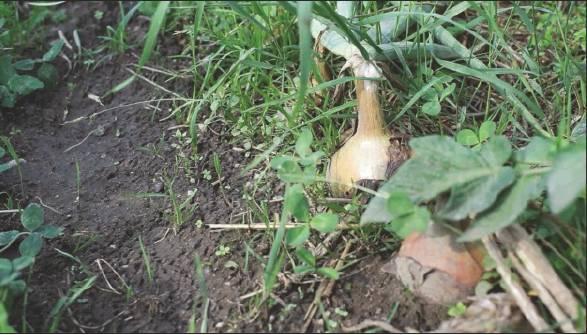Got Good Bugs?
When it’s time to plant, soil may not be the first thing on your mind. But once you dig a little deeper, it’s easy to see why it’s the key to having strong, thriving plants, and why simply planting in whatever soil you happen to have in the backyard isn’t necessarily the best idea.
Soil is a vital part of the natural environment. It is just as important as plants, animals, rocks, landforms, and rivers. It influences the distribution of plant species and provides a habitat for a wide range of organisms. It controls the flow of water and chemical substances between the atmosphere and the earth and acts as both a source and store for gases (like oxygen, nitrogen, and carbon dioxide) in the atmosphere. Soils not only reflect natural processes but also record human activities both at present and in the past. They are therefore part of our cultural heritage.
Soil, together with the plant and animal life it supports, the rock on which it develops, its position in the landscape and the climate it experiences, form an amazingly intricate natural system – more powerful and complex than any machine that man has created. Soil may look still and lifeless, but it’s not. It is constantly changing and developing through time. Soil is always responding to changes in environmental factors, along with the influences of man and land use. If the soil was still and lifeless nothing would grow in it!
Good soil, whether you’re talking about potting mix (used in containers) or garden soil (used in planting beds), is crucial for strong roots. Just like a plant’s leaves need the right growing conditions, roots also need certain things in order to thrive. In an ideal rooting environment, water, nutrients (plant food), and air are mixed in with soil particles, with plenty of space for them to travel where they need to go. This combination allows roots to grow and become strongly anchored between soil particles to support the above-ground parts of the plant.
If garden soil is soggy, hard, rocky, or lacking in nutrients, roots won’t be happy, and plants won’t thrive. But it’s important to know that poor soil can be changed. By adding the right materials, soil texture and composition can shift from soggy to well-drained, from hard to light and fluffy, from nutrient-free to nutrient-rich.
If good soil could be achieved merely by buying a bag of fertilizer from the garden center, most Americans would be boasting perfect soil. While fertility is obviously an aspect of good garden soil, there is much more involved.
• Good Texture - You often hear gardeners talk about their soil’s “crumb.” This refers to the texture of the soil. Good soil is crumbly, like cookie crumbs scattered over the top of an ice cream sundae. That crumbly texture takes work but is worth it.
• Healthy pH -Soil pH is the measurement of the acidity of your soil. This affects the minerals contained in garden soil and their availability to your plants. In general, the closer to neutral your soil is, the better your plants will be able to take up these minerals. Of course, some plants prefer a more acidic soil, but for most flowers, herbs, and vegetables, a more neutral pH is optimal.
• Plenty of Organic Matter - Organic matter is just dead plant and animal tissue, which decomposes and enriches your soil as humus. Humus is wonderful because it helps improve your soil’s texture by binding some of the smaller particles together, which increases your soil’s aeration. It also improves your soil’s ability to both absorb and drain moisture. Finally, organic matter helps provide nutrients to your plants. Microorganisms help break down the organic matter into its basic elements, which enables plants to absorb it and use it.
Microorganisms. What am I talking about? I am talking about tiny little lifeforms that we can’t see but that are extremely important to plant life all over the globe.
You see, in their natural environment, plants are part of a rich ecosystem including numerous and diverse microorganisms in the soil. Some of these microbes, such as mycorrhizal fungi or nitrogen fixing symbiotic bacteria, play important roles in plant performance by improving mineral nutrition. However, the full range of microbes associated with plants and their potential to replace synthetic agricultural inputs has only recently started to be uncovered.
Beneficial fungi protect the plant from pathogens and harmful microbes, as well as creating pathways in the soil that bring water and nutrients back to the plant from larger distances. Bacteria and fungi work together in decomposing organic material and making the nutrients available to the plant. This is a sustainable process that allows for the growth of healthy plants, without the need for fertilizers, pesticides, and other chemicals – just the way Mother Nature likes it.
So, what went wrong? Why can’t the plants in our backyards grow in the same manner? The answer is simple. The biology necessary to cycle nutrients to the plant and protect it are no longer present or not present in adequate numbers. So where did they go? Well, they were killed off by years of chemical fertilizers, pesticides, fungicides, over tilling and compaction.
Chemical fertilizers and other ~cides contain salts. Remember back to high school science where you learned about the process of osmosis? It’s the movement of water through a cell membrane from a solution of low concentration to high concentration. So where is the water in the soil located? It’s locked up in the cells of these microbes. When salts in the form of chemical inputs are added to the soil, the water is drawn out of the microbes and they are either killed or go into a dormant state. Now the plant is dependent on you to provide all of its food and protection. That’s why you have to fertilize on a regular basis.
In addition to damaging the biology in the soils, these chemicals are having other impacts of much greater consequence. Nitrates from fertilizers are leaching into our water system, and pesticide exposure has been linked to a variety of diseases such as cancer. There’s a reason that lawn companies recommend keeping children and pets off of lawns after they’ve been sprayed, these chemicals are highly toxic!
The problem for the home gardener is that most of our gardens do not contain enough microbially life in the soil, what can we do?
My simple answer is to stop tilling the soil, use plenty of good quality compost as mulch, top dressing, and side dressing, and use compost tea in your garden regularly.
Another great way to add microbes to your soil is to import them, while there are commercially available inoculants that are pretty good, I would recommend you simply take a walk in the woods. If you have a wooded area nearby, taking a few handfuls of that soil and putting it into your compost pile or even right into the garden itself will bring in some different microbes. A meadow or aquatic system will have yet other microbes – add them too. Be sure there is lots of organic material and they will grow and reproduce quickly.
We don’t want to be taking wheelbarrows full of soil out of these ecosystems, but a small amount won’t hurt. This is a quick, simple, affordable, and effective way of increasing microbial diversity in your garden.
Whether you are growing flowers, herbs, vegetables, a lawn, or a shrub border, healthy soil is an absolute must. Your plants will be less prone to pest and disease issues, they’ll grow better, and they’ll look better. With a bit of know-how, some work, and some patience, you can have healthy soil, no matter what kind of soil you are starting with.



